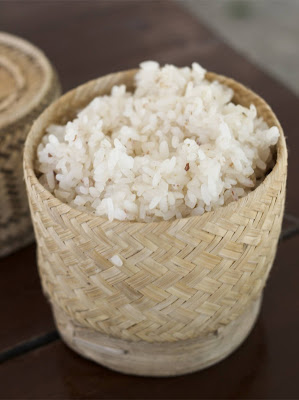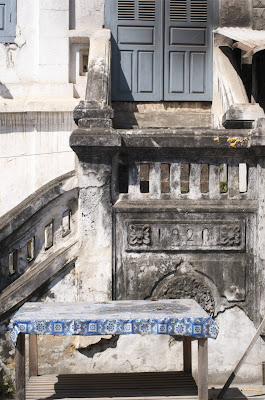The staple of Laotian food is sticky rice. It is served in small bamboo baskets, shaped and eaten by hand, always with three fingers, never four. Laotians say sticky rice is what makes them so languid, because it makes them stick to the ground. The Chinese eat steamed rice, they say, and are always rushing. (The country's full name is Lao PDR - the PDR standing for "Please Don't Rush", not People's Democratic Republic).
The country may be poor, but the land is fertile, and fresh ingredients abound. Wonderful fruit and vegetables, a lot of bamboo shoots. Like the Thais they use a lot of coriander, basil and mint. Unlike them, they shun coconut milk. They eat buffalo, as it is cheaper than beef. The flesh is rich and red, and looks gamey, but doesn't taste it. They cook on a Tao-Lo, which is basically a charcoal bucket, but fry and grill a lot of stuff - catfish, tilapia, chicken. Lao Sausage is always fried, and despite being fairly heavily rusked, is incredibly flavourful and addictive.
Cooking Lam on a Tao-Lo
They eat a lot of stew, or Lam, as well as Laap, a salad made with minced pork, chicken or fish, with a subtle array of herbs and chilli on the side. It is as fresh, clean and crisp as anything I have encountered on my travels. The food markets have all you can eat vegetable, noodle and rice buffets, and whatever grilled goods take your fancy. They sell soft boiled eggs marked with numbers to denote the developmental stage of the foetus inside, which I, unsurprisingly, decline.
I took a day's cooking class to get a feel for things. We started with Jaew Mak - a dip (eaten for breakfast with sticky rice!) made with eggplant or tomato, along with plenty of chilli, garlic and coriander. This is followed by Luang Prabang stew, that doesn't really do it for me, and the unquestionable highlight, stuffed lemongrass. You slice a few inches of lemongrass, without cutting right through the stem, creating a kind of basket into which you stuff minced chicken, coriander, lime and garlic. Or try to at least. Then they're coated in egg and fried, though I think I'll be putting them on the barbecue when I get home.
We have a choice of swapping the steamed fish in banana leaf for a steamed frog. I plump for the fish, partly because I find frogs to be repulsive creatures and have no desire to hold one's pulsating limbs in my hand whilst administering a deadly pestle blow to its head, but also because they yield precious little meat. Marcos, the guy next to me gets involved, killing then butchering the little guy with notable expertise (it transpires he is a vet).
Frog filleting
You can't eat without drinking, and you can't eat Laotian food without drinking Beerlao. Like everything else in this country, I love it. It's the best beer in Asia, comes in oversized pint bottles, and is acclaimed by connoisseurs, experts, expats, travellers and locals alike. Traditional Lao Lao Whisky is not quite so drinkable, being made from rice and tasting like fairly nasty grappa. Local attempts to enhance its 'flavour' by bottling it with snakes and scorpions result in a nose of pure alcohol infused with delicate reptilian aromas. On the palate it is frankly unpalatable, tasting like ten year old aquarium water with a few dead terrapins floating on the surface.
Lao Lao Whisky
I didn't eat a bad meal in Laos. Quite the opposite in fact; each one seemed to improve upon the last somehow. Just before leaving Luang Prabang I had a lunch of chicken and cashew nuts sat down by the river. It took forever to arrive, naturally, since no-one rushes and everything is cooked from scratch. When it came it was simple, fresh and brilliant, and by the time I'd finished it I really didn't want to leave at all, preferring to stay in Laos, eating something new and wonderful every day until I just grow old and die.




















































